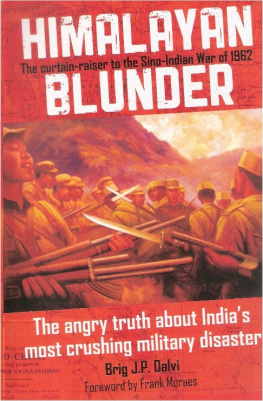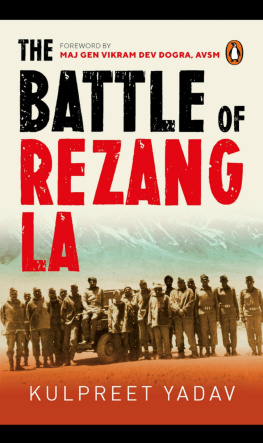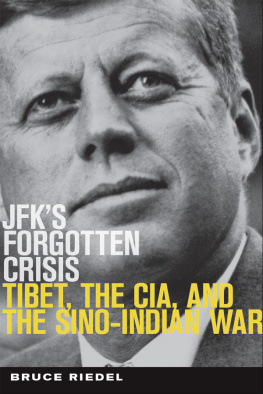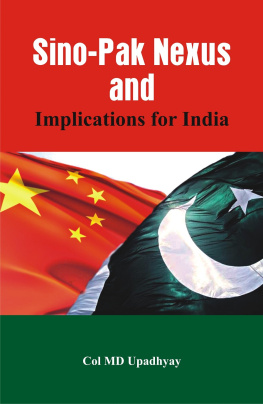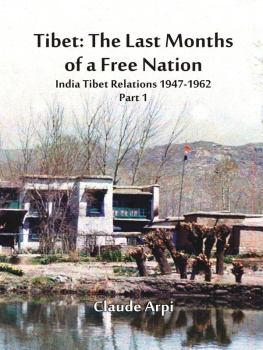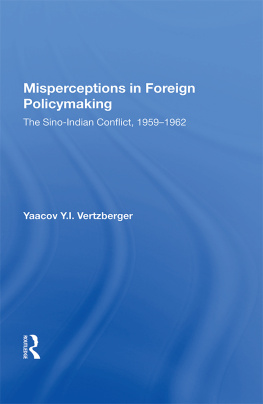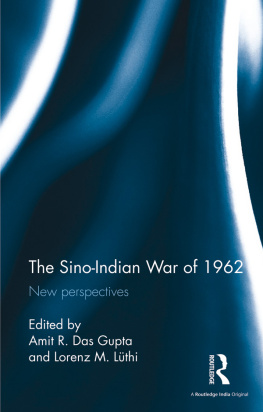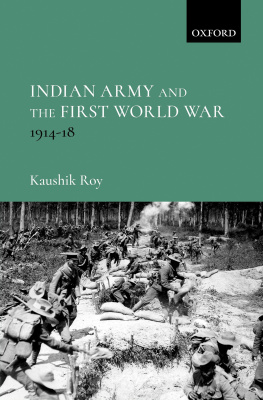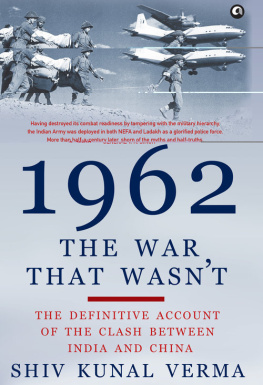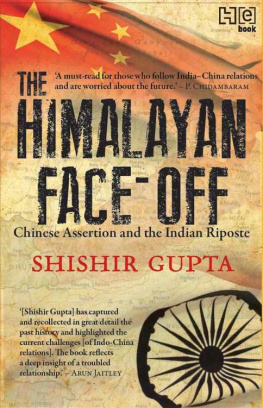HIMALAYAN BLUNDER
(The Curtain-Raiser to the Sino-Indian War of 1962)
BRIGADIER J. P. DALVI (RETIRED)

NATRAJ PUBLISHERS
Natraj Publishers
2/11 (Lower Ground Floor), Ansari Road
Darya Ganj, Delhi - 110002
www.NatrajBooks.com
First published in India by Thacker and Company Ltd. in 1969
Copyright J P Dalvi 1969
Brig. J P Dalvi asserts his moral right to
be identified as the author of this work
The Author and Publishers are committed to respecting the intellectual property rights of others and have made all reasonable efforts to trace the copyright owners of the images reproduced, and to provide appropriate acknowledgement within this book. In the event that any untraceable copyright owners come forward after the publication of this book, the Author and Publishers will use all reasonable endeavours to rectify the position accordingly.
All rights reserved. By payment of the required fees, you have been granted the non-exclusive, non-transferable right to access and read the text of this e-book on screen. No part of this text may be reproduced, transmitted, downloaded, decompiled, reverse engineered, or stored in or introduced into any information storage and retrieval system, in any form or by any means, whether electronic or mechanical, now known or hereinafter invented, without the express written permission of Natraj Publishers.
Source ISBN: 9788185019666
Ebook Edition September 2010 ISBN: 9788181581457
Version: 2010-09-23
DEDICATED TO
THE MEMORY OF ALL RANKS OF 7TH INFANTRY BRIGADE WHO LAID DOWN THEIR LIVES FOR INDIA IN THE BATTLE OF NAMKA CHU IN OCTOBER 1962
ACKNOWLEDGMENTS
No SERVING OFFICER has helped me in any way in the preparation of this book.
I am indebted to some civilian friends who helped me in producing this work, but who desire to remain anonymous.
My debt to my school friend, Lt. Col. C. L. (Larry) Proudfoot (Retd.) is incalculable. No formal acknowledgment can convey my gratitude for his comprehensive assistance at every stage of the preparation and production of this book. I am also grateful for the kind and generous hospitality extended to me by Connie and Larry Proudfoot during my prolonged visits to Bombay in connection with the publication of the book.
I wish to thank my brother, Colonel Jai Dalvi (Retd.), for his criticisms, constructive suggestions and for helping me in the search for background material.
I am indebted to the following authors for background material and permission to quote from books of their Copyright. Appropriate acknowledgement has been made in the text. I apologise in any case where such permission or acknowledgement has been overlooked.
The Battle of NEFA by G. S. Bhargava Allied Publishers.
China Invades India edited by V. B. Karnik Allied Publishers.
After Nehru Who? by Welles Hangen Rupert Hart Davis.
Chinese Invasion of NEFA by Major S. R. Johori Himalaya Publications.
Guilty Men of 1962 by D. R. Mankekar Tulsi Shah Enterprises.
Forging The Shield by Lt.-Gen. P. S. Bhagat, V.C. The Statesmen Press.
Cassino Portrait of a Battle by F. Majdalany Longman Green & Co.
The Desert Generals by Corelli Barnett The Viking Press.
"Auchinleck" by John Connell Cassell & Co. Ltd.
"The Donkeys" by Allen Clark William Morrow & Co.
The Guns of August by Mrs. Barbara Tuchman The MacMillan Co. of New York.
A History of Militarism by Alfred Vagts Meridian Books Inc.
The Untold Story by Lt. Gen. B. M. Kaul Allied Publishers.
The Statesman Supplement "Black November" of 20th November 1967.
Statement by the Hon'ble Y. B. Chavan, Defence Minister of the Union Cabinet of India, to the Lok Sabha, on 3rd September 1963.
"Lost Victories" by Field Marshal Eric von Manstein Henry Regnery Company, Chicago, U.S.A.
Finally, I owe a debt to Mr. Derek Pinto who made the drawings from my clumsy memory sketches.
CONTENTS
FOREWORD
I HAVE HAD occasion to read a number of books and other material on the Indian military debacle of October-November 1962 when the Chinese inflicted a humiliating reverse on our armed forces in NEFA and along the Himalayan border. These contributions have come from various sources, from soldiers, some of whom have participated in the fighting in various capacities, from bureaucrats, military correspondents, journalists and commentators.
Brigadier John Dalvis account not only of the disastrous thirty days conflict but of the policies and attitudes of mind which led to it, as also of the lessons to be drawn from that tragic confrontation gives this book an unusual dimension. The author had the advantage of being a participant in the fighting when on the morning of 20th October 1962 massed Chinese artillery opened up a heavy concentration on the weak Indian garrison in a narrow sector of the Namka Chu valley of Kameng Frontier Division in the North-East Frontier Agency (NEFA). Dalvi was taken prisoner and held in captivity for seven months during which as he writes poignantly, a wave of bitter shame for this country overwhelmed him.
This book is partly the result of those seven months of brooding and thinking. It is remarkable not only for its sensitive writing but for its thinking in depth. No soldier who passed through that searing experience, however generous his nature, could be impervious to a deep embitterment of spirit and feeling. It is to Dalvis credit that he does not allow this embitterment to cloud his judgement and thought.
He does not, however, spare those whom he believes were the guilty men. But neither his assessment of them nor his conclusions have the enveloping sweep of a flat vindictive indictment. Dalvi had evidently thought deeply over the military dangers inherent in the political policies of our omniscient know-alls in New Delhi long before the confrontation came. There is a dramatic but impressive picture of General Lentaigne, then commandant of the Defence Services Staff College in Wellington, boldly challenging a very senior official of the External Affairs Ministry who had given a talk on Sino-Tibetan relations justifying the policy of Chinas subjugation of Tibet. Lentaigne warned the complacent speaker - this was early in 1951 - of the military threat to India by the Chinese presence in Tibet.
Lentaigne, of course, was ignored, as were some others, by the all-seeing Pooh Bahs of New Delhi. Retribution came eleven years later. It is the great merit of Dalvis book that while he evidently has sufficient dynamite to blow some political and military reputations sky-high, he refrains from doing so merely for the heck of doing so.
None-the-less his book throws new light on certain decisive periods notably on the vague borderland of September-October 1962. His objects and objectives are not so much concerned with the past as with the future. Major mistakes, like minor diseases, are often preventible. If so, why are they not prevented ?
This is the question which Dalvi poses and asks. He is deeply concerned that these mistakes, exposed and analysed, should not be repeated, for it is obvious that he realises the basic reason why history repeats itself. History repeats itself because men repeat their mistakes.
I confess that I have never read an account of those tragic thirty days that has so stirred me cerebrally or moved me so emotionally. I think it is because Dalvis writing is an exercise in restraint, in the way he unfolds the evidence not merely to establish his case, but, going further, to suggest ways and means of improving our apparatus for the higher direction of war.

